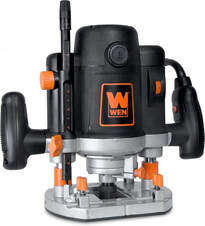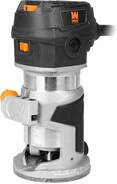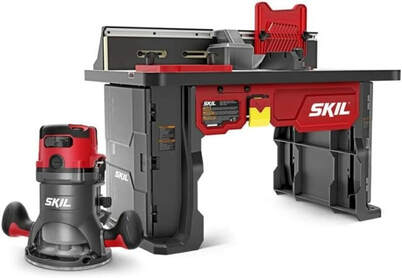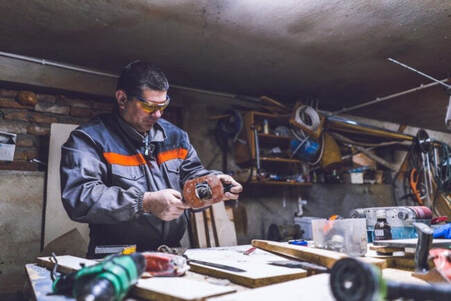USING ROUTERS AND ROUTER TABLE

Woodworking can challenge your DIY skills and encourage creativity. However, sticking to the most basic tools can be limiting. It’s helpful to familiarize yourself with different tools of the trade to keep your options open, and one such power tool is the woodworking router.
Using a router table or a handheld router, woodworkers can make cutouts, sharp edges, rounded edges, joints, decorative cuts, rabbets, and dadoes, and they can even make duplicates from a pattern. There are many router projects woodworkers can tackle with a standard cutting bit, but switching to one of several router bit shapes to create unique designs and intricate patterns can open up more customization options.
If you want to learn how to use a router the right way, this guide has you covered.
Using a router table or a handheld router, woodworkers can make cutouts, sharp edges, rounded edges, joints, decorative cuts, rabbets, and dadoes, and they can even make duplicates from a pattern. There are many router projects woodworkers can tackle with a standard cutting bit, but switching to one of several router bit shapes to create unique designs and intricate patterns can open up more customization options.
If you want to learn how to use a router the right way, this guide has you covered.
Important Router Parts
Knowing how to use and maintain a router tool properly begins with understanding the key parts of a router and how they function.
Knowing how to use and maintain a router tool properly begins with understanding the key parts of a router and how they function.
- Motor: An electric router typically has a vertically mounted motor that converts electrical energy into mechanical energy to drive the cutting blade.
- Collet: A collet is essentially a steel sleeve enclosed within a locking or retaining nut that secures the router bit in the router while working.
- Base: Handheld router bases have a hole in their center, through which the router bit protrudes to cut into the target material.
- Speed control: This dial can be used to increase or decrease the router cutter’s operating speed.
- Depth stop: A depth guide that can be preset to a specified depth for making cuts at consistent depths or stopping the router from being lowered too far into the material.
- On/off switch: A switch or trigger that turns the router on or off.
4 Types of Routers to Know
There are multiple common router types, including fixed-base routers, plunge routers, trim routers, and router tables.
There are multiple common router types, including fixed-base routers, plunge routers, trim routers, and router tables.

The most common type of handheld router is known as a fixed-base router. With this type of router, the position of the router bit remains fixed. For instance, if you set the cut depth to ¼ inch, the router bit will only protrude past the base ¼ inch until the depth is changed. Fixed-base routers are designed for a wide range of shaping and edging jobs. A fixed-base router is a good option as a first router to get started, since it is relatively easy to learn how to operate and often costs less than plunge routers or router tables.

A plunge router tends to provide greater ease and control when woodworking because the tool’s base can rest on the material surface while the router blade is lowered for the cut. This is in contrast to a fixed-base router, where the bit protrudes from the bottom of the router to a set depth. Experienced woodworkers can use plunge routers to create dovetail, groove, dado, and mortise cuts, as well as deep through cuts. Just make sure to set the depth stop to avoid inadvertently cutting deeper into the material than originally intended.

Similar to a fixed-base router, a trim router is a smaller tool best suited to cutting through thin pieces of wood or laminate. Most trim or laminate routers have small, light-duty designs and are easy to guide with one hand. Expect these tools to have smaller motors than fixed-base and plunge routers, so they may not be the best general-purpose tool option.
A guide fence for straight cuts, trim guide for curved cuts, and variable speed dial help this trim router produce optimal results.
A guide fence for straight cuts, trim guide for curved cuts, and variable speed dial help this trim router produce optimal results.

One drawback of a handheld router is that the tool relies on the user for control and accuracy. If the router slips, shifts, or kicks back, material can potentially be cut, nicked, or otherwise damaged. However, a router table can help improve control and accuracy by providing a stationary position in which the router tool can sit. Once attached to the router table, the router bit sticks up out of the table surface. The material can then be guided into the blade for a variety of jobs, including shaping trim, cutting rabbets, or making tongue-and-groove edges.
Router Safety Tips
Consider these key safety tips before picking up a router, so you can stay safe while you work.
Consider these key safety tips before picking up a router, so you can stay safe while you work.
- Keep a firm, two-hand on the router, especially when the bit first comes in contact with the material. This also helps to keep control of the tool if it becomes stuck in the material and kicks backs while in use.
- Make sure to disconnect the power to the router when changing bits, performing router maintenance, cleaning the tool, or mounting router attachments.
- Make personal protection a priority when using a router. Put on long pants, a long-sleeve shirt, closed-toe shoes, gloves, safety glasses, a dust mask, and consider using ear plugs or similar hearing protection.
- Regularly inspect, clean, and maintain the router to ensure that it functions properly while you work. Replace worn-out parts, discard old bits, and make repairs as necessary to keep the tool in good condition.
Initial Setup and Calibration
An initial setup, inspection, and speed calibration is necessary before attempting to use a router. Typically, a 2 horsepower (hp) router is suitable for most DIY and home woodworking jobs. You can also get small, 1.25hp routers for trim, or full-size 3hp routers if you feel the need for extra power. Before using a new router, consult the owner’s manual to get a detailed breakdown of the parts and controls.
An initial setup, inspection, and speed calibration is necessary before attempting to use a router. Typically, a 2 horsepower (hp) router is suitable for most DIY and home woodworking jobs. You can also get small, 1.25hp routers for trim, or full-size 3hp routers if you feel the need for extra power. Before using a new router, consult the owner’s manual to get a detailed breakdown of the parts and controls.
- Disconnect the power and turn off the power switch before changing bits.
- Select the appropriate router bit for the job by checking the type, shank strength, cutting length, cutting diameter, and sharpness of the bit.
- Set the router bit depth to ensure that you don’t cut deeper into the material than intended.
- Make sure the set speed is suitable for the target material.
- Test the bits, attachments, clamps, and locking devices to ensure that they are properly tightened and secured.
- Clamp the target material to prevent it from shifting while you work.
- Clear the immediate area of any people or pets.
- Connect the power and line up the router bit to make the initial cut.
- Set up a guide fence to make straight cuts in the material or use a trim guide for curved cuts.
- Do not bring the router bit into contact with the material until it has had enough time to speed up, otherwise the bit may kick back instead of cutting through.
How to Use a Router for Cutting Decorative Edges

A common use for routers is to cut decorative edges into a project to give it a more intricate finish. Follow these steps to learn how to cut decorative edges into the target material with your router.
STEP 1: Select a suitable bit, set the depth, and position the router.
The bit for the job typically depends on the type of cut desired. For cutting straight through wood, a basic straight bit is the best choice, but if you want to make round edges, then it’s better to go with a round-over bit. There are a wide assortment of router bits available for making decorative edges. Keep in mind that the type of decorative edge is determined by the type, size, and shape of the router bit. Consider which bit would be right for your project and insert it into the collet.
Check the depth of the bit and set it to the desired level, then line up the router with the material. It’s important to note that for the best results, you may need more than one pass with the router to get an accurate cut. The router bit should be set to a shallow depth to remove a small amount of material with the first pass. Reset the depth to take off more material with the second pass. Repeat this process as necessary for a smooth finish.
STEP 2: Turn on the router and begin cutting the material.
Connect and turn on the router, then let the bit get up to speed. Do not touch the bit to the material before it has had time to speed up or it might kick back. When the bit is at the set speed, move the router to start cutting into the material.
Keep in mind that the router direction matters. Always push the router from left to right for routing the perimeter of the material and push the router from right to left if you are routing an interior cut. If left and right are a bit confusing, you can also think of it in terms of a clock. Push the router in a counterclockwise direction when you are routing the perimeter and push the tool in a clockwise direction when working on an interior cut. This means that the router should be moving against the rotation of the bit.
However, in some cases, the grain might pull away when you attempt to move the router in the usual direction. In these instances, you will need to use climb-cutting to finish the cut. With climb-cutting, the user pushes the router with the rotation of the bit instead of against it.
STEP 1: Select a suitable bit, set the depth, and position the router.
The bit for the job typically depends on the type of cut desired. For cutting straight through wood, a basic straight bit is the best choice, but if you want to make round edges, then it’s better to go with a round-over bit. There are a wide assortment of router bits available for making decorative edges. Keep in mind that the type of decorative edge is determined by the type, size, and shape of the router bit. Consider which bit would be right for your project and insert it into the collet.
Check the depth of the bit and set it to the desired level, then line up the router with the material. It’s important to note that for the best results, you may need more than one pass with the router to get an accurate cut. The router bit should be set to a shallow depth to remove a small amount of material with the first pass. Reset the depth to take off more material with the second pass. Repeat this process as necessary for a smooth finish.
STEP 2: Turn on the router and begin cutting the material.
Connect and turn on the router, then let the bit get up to speed. Do not touch the bit to the material before it has had time to speed up or it might kick back. When the bit is at the set speed, move the router to start cutting into the material.
Keep in mind that the router direction matters. Always push the router from left to right for routing the perimeter of the material and push the router from right to left if you are routing an interior cut. If left and right are a bit confusing, you can also think of it in terms of a clock. Push the router in a counterclockwise direction when you are routing the perimeter and push the tool in a clockwise direction when working on an interior cut. This means that the router should be moving against the rotation of the bit.
However, in some cases, the grain might pull away when you attempt to move the router in the usual direction. In these instances, you will need to use climb-cutting to finish the cut. With climb-cutting, the user pushes the router with the rotation of the bit instead of against it.
STEP 3: Make a pass with the router to cut the decorative edge.
As the router bit is cutting into the material, move the router along the edge of the material to start creating the decorative edge. Begin with the grain sides first because if you get a tear-out on the corners, you can clean them up as you route the other two sides. Move the router at a steady pace while routing in a counterclockwise direction for perimeter cuts and in a clockwise direction for interior cuts.
STEP 4: Reset the depth and route the final pass.
After the first pass is complete, reset the depth and route the next pass. Repeat this process as necessary until you route the final pass. Some projects will require only two passes, though others may require three or four to get the desired results.
As the router bit is cutting into the material, move the router along the edge of the material to start creating the decorative edge. Begin with the grain sides first because if you get a tear-out on the corners, you can clean them up as you route the other two sides. Move the router at a steady pace while routing in a counterclockwise direction for perimeter cuts and in a clockwise direction for interior cuts.
STEP 4: Reset the depth and route the final pass.
After the first pass is complete, reset the depth and route the next pass. Repeat this process as necessary until you route the final pass. Some projects will require only two passes, though others may require three or four to get the desired results.
How to Use a Router for Cutting Rabbets and Dadoes
A rabbet refers to a step-shaped or L-shaped cut along the edge of a piece of wood, creating a shoulder in the material. It’s typically made to form a match to the edge or tongue of another piece to create a rabbet joint. Another common cut that you can do with a router is called a dado. This refers to a grooved cut in the face of a board. It’s usually cut across the grain and is intended to fit the edge of another board to form a dado joint.
STEP 1: Select a suitable bit, set the depth, and position the router.
To cut a dado or a rabbet, it’s usually best to use a straight or rabbeting router bit. Set the desired depth for the project, but make sure that the initial depth is more shallow than the final depth. The purpose of this shallow setting is to remove a small amount of material with the first pass before resetting the depth for a subsequent pass. By making cuts with more than one pass, a woodworker helps reduce the chance of burning the wood, wearing out the bits, or damaging the piece.
Line up the router and bit with the area that will be cut. Consider using one or more guide fences to ensure that the cut is straight.
STEP 2: Turn on the router and begin cutting the material.
Connect the router, turn on the switch, and allow the router bit to speed up. Do not touch the router bit to the material before it has reached the set speed because the bit may get caught or kick back off the material if it is not operating at a high enough speed. Once the router bit is up to speed, move the router bit to the material to start cutting.
For a rabbet joint, push the router counterclockwise across the edge of the material to cut an L-shaped shoulder. If you are cutting a dado, push the router counterclockwise across the face of the material to create a grooved cut in the face of the board.
STEP 3: Reset the depth and route the final pass.
After making the initial cut, reset the depth, and push the router through a second pass to remove more material. Depending on the desired depth, you may only need two passes to complete the rabbet or dado cut, but cuts might require three or four passes to get the desired result.
Other Router Projects for Beginners
Beyond finishing edges and routing rabbets and dados, here are a few more common applications for this versatile power tool.
Shaping stylish molding: Decorative molding is perhaps the most interesting thing a router can create. Using different bits, you can craft everything from simple rounded moldings to more elaborate Roman ogee or beaded patterns for doors, windows, baseboards, or chair rails.
Recreating patterns: Routers can be used to cut patterns, grooves, and designs across multiple pieces of wood. For instance, if you have a broken table or other piece of wood, you can use the router to “trace” the outline of the original piece and re-create it as many times as you like. Routers can also be used on flat pieces of wood to trace intricate designs or lettering.
Recessing door hinges: Routers can be used with a jig to cut space for recessed door hinges or lock faceplates. Recessed hardware yields a more finished appearance and smoother operation.
A rabbet refers to a step-shaped or L-shaped cut along the edge of a piece of wood, creating a shoulder in the material. It’s typically made to form a match to the edge or tongue of another piece to create a rabbet joint. Another common cut that you can do with a router is called a dado. This refers to a grooved cut in the face of a board. It’s usually cut across the grain and is intended to fit the edge of another board to form a dado joint.
STEP 1: Select a suitable bit, set the depth, and position the router.
To cut a dado or a rabbet, it’s usually best to use a straight or rabbeting router bit. Set the desired depth for the project, but make sure that the initial depth is more shallow than the final depth. The purpose of this shallow setting is to remove a small amount of material with the first pass before resetting the depth for a subsequent pass. By making cuts with more than one pass, a woodworker helps reduce the chance of burning the wood, wearing out the bits, or damaging the piece.
Line up the router and bit with the area that will be cut. Consider using one or more guide fences to ensure that the cut is straight.
STEP 2: Turn on the router and begin cutting the material.
Connect the router, turn on the switch, and allow the router bit to speed up. Do not touch the router bit to the material before it has reached the set speed because the bit may get caught or kick back off the material if it is not operating at a high enough speed. Once the router bit is up to speed, move the router bit to the material to start cutting.
For a rabbet joint, push the router counterclockwise across the edge of the material to cut an L-shaped shoulder. If you are cutting a dado, push the router counterclockwise across the face of the material to create a grooved cut in the face of the board.
STEP 3: Reset the depth and route the final pass.
After making the initial cut, reset the depth, and push the router through a second pass to remove more material. Depending on the desired depth, you may only need two passes to complete the rabbet or dado cut, but cuts might require three or four passes to get the desired result.
Other Router Projects for Beginners
Beyond finishing edges and routing rabbets and dados, here are a few more common applications for this versatile power tool.
Shaping stylish molding: Decorative molding is perhaps the most interesting thing a router can create. Using different bits, you can craft everything from simple rounded moldings to more elaborate Roman ogee or beaded patterns for doors, windows, baseboards, or chair rails.
Recreating patterns: Routers can be used to cut patterns, grooves, and designs across multiple pieces of wood. For instance, if you have a broken table or other piece of wood, you can use the router to “trace” the outline of the original piece and re-create it as many times as you like. Routers can also be used on flat pieces of wood to trace intricate designs or lettering.
Recessing door hinges: Routers can be used with a jig to cut space for recessed door hinges or lock faceplates. Recessed hardware yields a more finished appearance and smoother operation.

CLEANING AND MAINTENANCE
One of the most important factors to keep in mind is that a router requires regular maintenance to ensure that it will continue operating properly. Use these router maintenance tips to ensure that your router lasts for years.
One of the most important factors to keep in mind is that a router requires regular maintenance to ensure that it will continue operating properly. Use these router maintenance tips to ensure that your router lasts for years.
- Don’t clean a router by blasting with a burst of high-pressure air from an air compressor. This often can force dust and dirt further into the machine. Instead, use a shop vac to clean out the router after every use. This will prevent sawdust from being pulled into the router by the cooling fan and creating future problems.
- Corded routers can put a lot of strain on the electrical wire as it constantly winds, unwinds, shifts, pulls, bends, and is maneuvered for better access to projects. Make sure to inspect the power cord for any areas that show signs of wear or significant strain. Repair or replace damaged parts before using the tool again.
- Cordless routers can also develop problems due to the constant insertion and removal of the battery packs. Check the batteries, battery compartment, and the battery contact areas for wear and tear. Make repairs or replace any parts that are too worn out to safely use.
- Routers typically have a plastic facing on the base that is intended to prevent the router from scratching or marking the surface of the material as you work. However, over time this facing can become dusty, grimy, or worn, so you need to ensure that the facing is clean and in good condition before using the router.